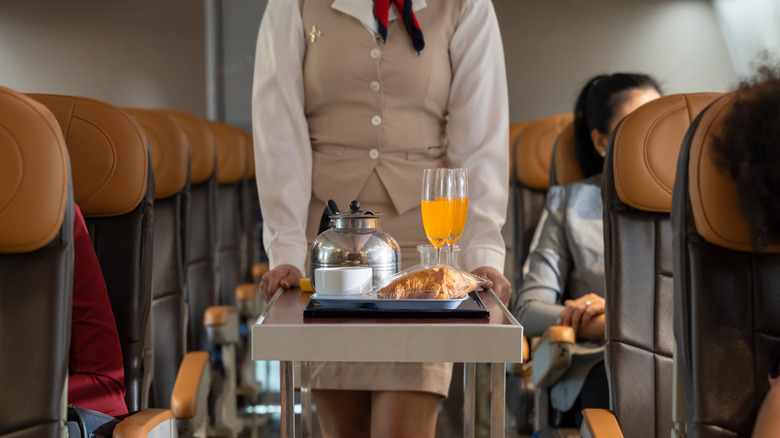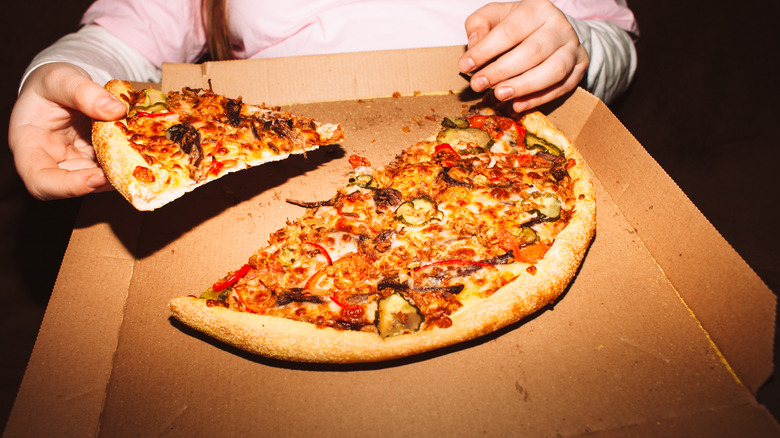3 BYO Foods Flight Attendants Wish They Didn't See On Planes
Despite airline food's fascinating history (which includes an era of luxury dining in the sky), unless you're flying first class, the meal you'll get on a flight is mediocre at best. On a budget flight that doesn't include food, you might be forced to buy an overpriced sandwich if you get peckish at 30,000 feet. While bringing a snack or a meal on a flight means you're not left at the mercy of the in-flight service, it's not quite the same as packing a lunch you might take to work or on a road trip. For one, the TSA 3-1-1 rule applies to food as well, meaning liquids and certain mushy foods like dips or cream cheese are subject to a 3.4-ounce limit. Additionally, keep in mind that you are sharing a confined space with other passengers and the airline crew for an extended period during a flight, so choose the food you carry accordingly.
From causing inconvenience and discomfort to fellow passengers to actually having to get rid of items deemed too strong-smelling by crew members, some foods are a major no-go in the fly zone. Chowhound spoke with veteran flight attendant and journalist Barbi on the most problematic foods passengers end up carrying on flights. "All airlines have company policies that crew members are required to follow for handling passenger complaints and disruptive behavior, including issues over foul or offensive-smelling foods or items," she explains. And it's not just the smell but also the potential mess and space it takes up that can make a certain food item impractical and problematic to fly with.
Pungent and strong-smelling foods
The biggest offenders are generally foods with particularly strong smells since they affect a wider sphere of people than just those sitting immediately next to you. If you're considering carrying something like boiled eggs, fish, or even cooked broccoli, think again. While they may seem alright to eat in well-ventilated areas, the same foods can leave a persistent odor in the confined cabin of an airplane. While there's no hard and fast list of foods to not carry, there are certain ones to be wary of. "I would never make a passenger give up their tuna sandwich unless, of course, it's smelling up the entire plane," Barbi Walsh says. It's best to gauge beforehand just how pungent your packed flight meal might be, and if in doubt, avoid carrying it.
Walsh also advises one to expect certain pungent smells when flying abroad. "I fly internationally and to Asia a lot, so I'm used to the smell of kimchi on the plane. It's included on the meal trays we serve," she says. "My experience with passengers is very different from that of someone who works three or four legs a day flying domestic flights." Remember that various parts of the world have differing definitions of smelly food.
Foods that are messy to eat
Another situation that has airline crew rolling their eyes is when someone doesn't consider beforehand just how messy eating their packed meal is going to be. "If they've brought on something like oysters on the half-shell, that would be cringy and way over the top messy," Barbi Walsh quips.
While oysters may seem like an extreme example, she points to something like bone-in wings and ranch dip to also be particularly messy to eat midair. Another offender Walsh recommends watching out for is spaghetti, which can spray sauce splashes even when eaten on a regular table, much less a tiny airplane tray. Some types of salad, especially those with large leaves, can also cause a bit of a mess, and you risk getting stray dressing and crumbs on those sitting next to you.
Foods that are difficult to eat in tight spaces
While it's possible to carry fast food through airport security, provided it's not accompanied by a drink, walking into your flight with a pizza box will likely get you some (well-deserved) stares from the flight crew. Not only is opening a pizza box on your seat going to disturb passengers immediately around you, but getting rid of the box will actually be quite the hassle for flight attendants because of the limited space for trash on the plane.
"It all depends on how it's packaged and how easily it is for the passenger to eat in a tight space," Barbi Walsh explains, saying that even large, messy burgers may not be ideal on a flight. In general, it's a good idea to avoid foods that may require you to use both hands to eat, like a large piece of corn on the cob. Not only is it likely to infringe on the personal space of someone in the next seat, you're also susceptible to having your elbow knocked while eating, which could result in dropped food and an even bigger mess.



